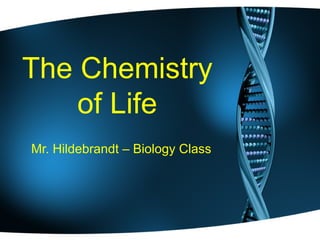The Chemistry of Life
•
23 likes•13,045 views
This slideshow is intended for students in Mr. Hildebrandt's biology classes.
Report
Share
Report
Share

Recommended
More Related Content
What's hot
What's hot (20)
Chemistry - Chp 1 - Introduction To Chemistry - PowerPoint

Chemistry - Chp 1 - Introduction To Chemistry - PowerPoint
Similar to The Chemistry of Life
Similar to The Chemistry of Life (20)
Carbon Chemistry and Applications - Gurumurthy B R

Carbon Chemistry and Applications - Gurumurthy B R
More from Shakopee Public Schools
More from Shakopee Public Schools (20)
The Chemistry of Life
- 1. The Chemistry of Life Mr. Hildebrandt – Biology Class
- 2. Important Terms • Matter – anything physical that takes up space • Mass – the amount of matter • Atom – basic unit of matter • Element – simplest form of matter • Combining Power – number of atoms an element can bond to • Compound – atoms of 2 or more elements held together by bonds
- 3. Chemical Bonds • Ionic bond – oppositely charged atoms are joined • Covalent bond – atoms joined by sharing electrons or “valences” A. Single: share 1 pair of electrons B. Double: share 2 pair C. Triple: share 3 pair
- 4. Polyatomic Compounds There are two types of compounds: • Inorganic (non-living) - do not contain the element Carbon • Organic – (living) do contain Carbon
- 5. The “C.H.O.N. Compounds” • Organic compounds that contain Carbon, Hydrogen, Oxygen & Nitrogen • Living organisms require four types for survival:
- 6. 1. Carbohydrates • Provide energy • Monosaccharides (simple sugars) are the building blocks • Disaccharides and Polysaccharides commonly exist
- 7. 2. Lipids • Provides energy storage • 8 categories including fats, waxes, & some vitamins (A,D,E,K)
- 8. 3. Proteins • Each unique protein performs specific duties • Some are enzymes (speed up reactions) • Smaller amino acids are the building blocks
- 9. 4. Nucleic Acids • Stores all genetic information • Two main types: DNA & RNA • Nucleotides are building blocks
